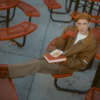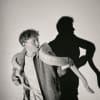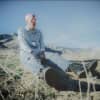The crudely-drawn cover art to Wondrous Bughouse, Idaho native Trevor Powers' recently released sophomore LP as Youth Lagoon, is like some sort of lysergic landscape, filled with such oddities as miniature solar systems, a godlike pheasant and a couple fish swimming blissfully through the sky. The record itself is equally packed with wonders, with large-scale pop songs and tight, visceral melodies that even a child could hum. But it’s the smaller things—the alien sound effects on “Attic Doctor,” the muffled outro on “Raspberry Cane,” the cover's tiny sailboat floating in a crimson sea—that ultimately make it so easy to get lost in Wondrous Bughouse. We spoke to Powers about seeking solace in mountaintop bars, the origin of the weirdly perfect album art and watching movies that only exist inside his mind.
Stream: Youth Lagoon, "Mute"
Did you know you were going to recruit a full band while you were working on the record? Definitely. I knew that I needed to, to make it happen. I only have two arms. The record was done at the beginning of December and as soon as I hired people, rehearsal started instantly. There’s this massive warehouse type place that I rented out. We just set up shop in there for the past two months.
Have you found time to do anything other than rehearse? I guess I didn’t really have much of a life for two months. Rehearsal would maybe go five, six hours a day and there would be days off in between. The days off I kind of just zone out. Maybe hang out with people or grab drinks downtown. It was nice not doing anything. There’s this cool place up in the mountains, it’s an hour away from Boise. They have the raddest bars up there. They’re practically lumberjack bars. Me and buddies would just go up there and hang out at those places, to get away. It has this really old architecture, like nothing’s been touched for ages.
How did you approach writing these songs differently than The Year of Hibernation? I have mainly just been getting more into exploring sonically. I approached this record from this mindset that if something feels too comfortable I’m probably in a place that I shouldn’t be. A lot of inspiration I’ve been taking from music where the melodies are hidden, things that are very drone-y and hypnotic, where the sounds just keep going and going. Like the band This Heat, and their album Repeat that came out in ’93, I think. There’s a song called “Metal” on it, and it’s just kind of a lot of this clanging metal noises that go on for like 18 minutes. It’s very expressive. If you stick to what you’re comfortable with, you run out of ways to say things.
A lot of your lyrics have contained some fantastical and spiritual images. When did you become interested in this kind of metaphysical thinking? I always have been. But I started doing a little more research. The song “Sleep Paralysis,” for instance, was inspired by this thing I read about this woman would go under sleep paralysis when she would fall asleep. She would be like half awake and half asleep. Her mind was still completely turned on. Her boyfriend or her husband or something like that was murdered, and she would see him in her room. She would also talk about seeing demons. Some people would say that that you’re actually just dreaming. Other people would say you’re kind of one foot in the spiritual dimension and one foot out of it. I’ve been getting more into writing in a way that’s more idea based. But certain songs are still very, very personal. My music is always therapeutic in a sense. I do a lot of writing in general, journaling and stuff like that. Even down to just drawing pictures of things and not thinking too much —just drawing and all of a sudden you’ll start to realize what’s been in your subconscious. The whole record was written in that way. Nothing was on purpose.
Stream: Youth Lagoon, "Dropla"
So are you often inspired by drawings or other types of visual art? Film? I definitely am. I don’t study those things all the time. I’ll just randomly stumble on certain things. In Hollywood movies everything has a beginning and has an end and everything like, makes sense. In my mind, when I’m writing songs, I’ll visualize certain things, but none of it makes sense. It’s just random blinks of images.
How did you decide on the album art? I stumbled on this book that was published in West Germany, it’s called Rausch Im Bild. There was this guy that was researching drug patients back in the 70s and early 80s. He had them draw pictures and write literature to see where there mind’s were at after experimenting with drugs and stuff. I stumbled on what’s now the cover on the internet, and I had this strange connection to it. I didn’t even have a backup plan. I was like, That has to be it.
Do you spend a lot of time on the internet? Quite a bit, yeah. It gets addicting. Sometimes I’m on there for much longer that I thought I would be. Does that every happen to you?


